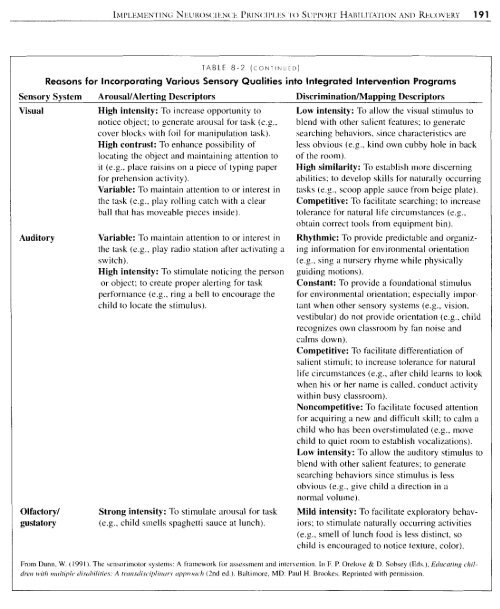Implementing Neuroscience Principles to Support Habilitation and ...
Implementing Neuroscience Principles to Support Habilitation and ...
Implementing Neuroscience Principles to Support Habilitation and ...
Create successful ePaper yourself
Turn your PDF publications into a flip-book with our unique Google optimized e-Paper software.
TABLE 8-2 (CONTINLIED)<br />
Reasons for Incorporating Various Sensory Qualities in<strong>to</strong> Integrated Intervention Programs<br />
Sensory System ArousallAlerting Descrip<strong>to</strong>rs DiscriminationIMapping Descrip<strong>to</strong>rs<br />
Visual<br />
Audi<strong>to</strong>ry<br />
Olfac<strong>to</strong>ry1<br />
gusta<strong>to</strong>ry<br />
High intensity: To increase opportunity <strong>to</strong><br />
notice object; <strong>to</strong> generate arousal for task (e.g.,<br />
cover blocks with foil for manipulation task).<br />
High contrast: To enhance possibility of<br />
locating the object <strong>and</strong> maintaining attention <strong>to</strong><br />
it (e.g., place raisins on a piece of typing paper<br />
for prehension activity).<br />
Variable: To maintain attention <strong>to</strong> or interest in<br />
the task (e.g., play rolling catch with a clear<br />
ball that has moveable pieces inside).<br />
Variable: To maintain attention <strong>to</strong> or intere\t in<br />
the task (e.g., play radio station after act~vating a<br />
switch).<br />
High intensity: To stimulate noticing the person<br />
or object; <strong>to</strong> create proper alerting for task<br />
performance (e.g., ring a bell <strong>to</strong> encourage the<br />
child <strong>to</strong> locate the stimulu\).<br />
Strong intensity: To stimulate arousal for task<br />
(e.g., child smells spaghetti sauce at lunch).<br />
Low intensity: To :~llow the visual stimulus <strong>to</strong><br />
blend with other salient features; <strong>to</strong> generate<br />
searching behaviors. since characteristics are<br />
less obvious (e.g., kind own cubby hole in back<br />
of the room).<br />
High similarity: To establish more discerning<br />
abilities; <strong>to</strong> develop skills for naturally occurring<br />
tasks (e.g., scoop apple sauce from beige plate).<br />
Competitive: To facilitate searching; <strong>to</strong> increase<br />
<strong>to</strong>lerance for natural life circumstances (e.g.,<br />
obtain correct <strong>to</strong>ols from equipment bin).<br />
Rhythmic: To provide predictable <strong>and</strong> organizing<br />
information for environmental orientation<br />
(e.g., sing a nursery rhyme while physically<br />
guiding motions).<br />
Constant: To provide a foundational sti~nulus<br />
for environmental orientation; especially important<br />
when other sensory systems (e.g., vision,<br />
vestibular) do not provide orientation (e.g.. child<br />
recognizes own classroom by fan noise <strong>and</strong><br />
calms down).<br />
Competitive: To facilitate differentiation of<br />
salient stimuli; <strong>to</strong> increase <strong>to</strong>lerance for natural<br />
life circumstances (e.g., after child learns <strong>to</strong> look<br />
when his or her name is called. conduct activity<br />
within busy classroom).<br />
Noncompetitive: To facilitate focused attention<br />
for acquiring a new <strong>and</strong> difficult skill; <strong>to</strong> calm u<br />
child who has been overstimulated (e.g., move<br />
child <strong>to</strong> quiet room <strong>to</strong> establish vocalizations).<br />
Low intensity: To allow the audi<strong>to</strong>ry stimulus <strong>to</strong><br />
blend with other salient features; <strong>to</strong> generate<br />
searching behaviors since stimulus is less<br />
obvious (e.g., give child a direction in a<br />
normal volume).<br />
Mild intensity: To facilitate explora<strong>to</strong>ry behaviors;<br />
<strong>to</strong> stimulate naturally occurring activities<br />
(e.g., smell of lunch food is less distinct, so<br />
child is encouraged <strong>to</strong> notice texture, color).<br />
From Dunn, W. (1991). The sensorimo<strong>to</strong>r systems A framework lor assessment <strong>and</strong> intervention. In F. P. Orelove & D. Sobsey (Eds.), Educnting chi/-<br />
dwrr ~'it/i I~IIIII~~IL' di.sd~ilitie~: A trut~.sdi.~(~i/~li~~~~r~<br />
(11)l>ro(r(.h(2nd ed.). Baltimore, MD: Paul H. Brookes. Reprinted with permission.





